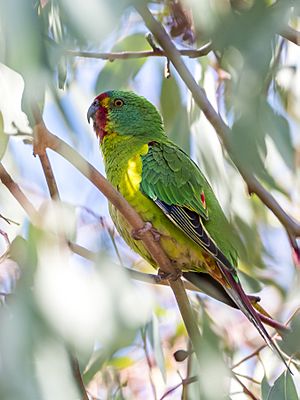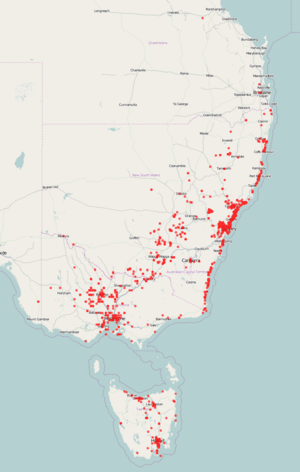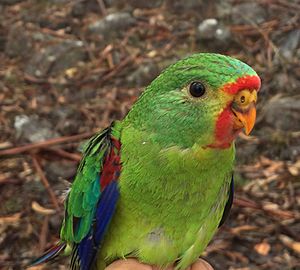Swift parrot facts for kids
Quick facts for kids Swift parrot |
|
|---|---|
 |
|
| A visiting migrant in Canberra, Australian Capital Territory | |
| Conservation status | |
| Scientific classification | |
| Genus: |
Lathamus
|
| Species: |
discolor
|
 |
|
| Distribution of the swift parrot From Atlas of Living Australia |
|
The swift parrot (Lathamus discolor) is a special type of broad-tailed parrot. You can only find it in southeastern Australia. These parrots breed in Tasmania during the summer. Then, they fly north to southeastern mainland Australia for the winter. They travel from Griffith to Warialda in New South Wales. They also fly west to Adelaide.
Swift parrots are like nomads; they move around a lot. They only settle in an area if there is enough food. Sadly, this species is in great danger. It is called critically endangered. One big problem is that sugar gliders eat the female parrots and their nests. This happens most where forests are cut down a lot. Scientists think there are fewer than 300 swift parrots left. Some studies even suggest they could disappear by 2031.
Contents
About the Swift Parrot
What Does It Look Like?
The swift parrot is about 25 centimeters (10 inches) long. It has long, pointed wings and a long, thin tail. Most of its body is green. It has a bluish head and red on its face, both above and below its beak. There is also a red patch at the top edge of its wing.
Female swift parrots are a bit duller in color. Young parrots have dark brown eyes and a pale orange beak. These birds are very noisy and always busy. They fly very fast and are easy to spot.
Where Do They Live?
Swift parrots live in many places. They can be found in forests, woodlands, and even on farms. Sometimes, they visit plantations and city areas too.
What Do They Eat?
Swift parrots mostly eat nectar from flowers. They especially love the nectar from Eucalyptus trees. In Tasmania, they choose breeding spots based on where their favorite food trees are blooming. These include Eucalyptus globulus and Eucalyptus ovata. In winter, they eat from many different Eucalyptus trees across mainland Australia.
Life Cycle and Breeding
Reproduction in Tasmania
Swift parrots breed in Tasmania from September to February. They build their nests inside holes in trees. But they are very picky about which holes they use. They like holes with small openings, deep insides, and wide floors. These special holes are rare. Only about 5% of tree holes in Tasmanian forests are suitable. These types of holes are usually found in very large trees.
These specific nest holes help protect their babies from predators. But these holes are easily damaged. For example, wildfires have destroyed many known swift parrot nests.
Threats to Nests
Cutting down forests is a big problem for swift parrots. This is mainly due to logging. In one important breeding area, 33% of the forest was lost or disturbed between 1996 and 2016. About 23% of their possible nesting spots were logged in the same time. When forests are cut down, it also makes other threats worse. For example, sugar gliders become a bigger problem.
Swift parrots choose where to breed based on food and nesting spots. They need both their favorite food (nectar) and good nesting holes nearby. They try to nest where food is most plentiful. This helps them raise their young in the best conditions. A successful swift parrot nest usually has about 3 to 4 eggs. About 3 chicks usually fly out of the nest.
However, sugar gliders are a major threat. Sugar gliders were brought to Tasmania and are not native there. They eat swift parrot eggs and chicks. In some places, sugar gliders cause almost all swift parrot nests to fail. This happens more often where there is less mature forest cover. Sugar gliders can live well even in disturbed forests. On islands where there are no sugar gliders, swift parrots have much more success raising their young.
Migration and Distribution
Where Do Swift Parrots Travel?
Swift parrots are a single group of birds that move around a lot each year. They can be found in a very large area. But they only stop in a place if there is food available. In Tasmania, they need both food and good nesting spots close by to breed.
Every year, swift parrots fly across Bass Strait. This is the sea between Tasmania and mainland Australia. They arrive in Tasmania in September. They fly back to southeastern Australia in March and April. They can travel as far north as southeastern Queensland. They also go as far west as Adelaide in South Australia. However, recently they have mostly been seen in the southeastern part of South Australia.
Because they move around so much, it's hard to guess exactly where they will be. They do return to the same places often. But they might only visit if there are enough flowering trees that year.
Important Bird Areas
BirdLife International has found many places that are very important for swift parrots. These are called Important Bird Areas.
- New South Wales
- Brisbane Water
- Capertee Valley
- Hastings-Macleay
- Hunter Valley
- Lake Macquarie
- Richmond Woodlands
- South-west Slopes of NSW
- Tuggerah
- Ulladulla to Merimbula
- Victoria
- Bendigo Box-Ironbark Region
- Maryborough-Dunolly Box-Ironbark Region
- Puckapunyal
- Rushworth Box-Ironbark Region
- St Arnaud Box-Ironbark Region
- Warby-Chiltern Box-Ironbark Region
- Tasmania
- Bruny Island
- Maria Island
- South-east Tasmania
Conservation Status
Why Are They Endangered?
Scientists have studied the swift parrot's numbers. They found that it is Critically Endangered. This means it is at very high risk of disappearing forever. Other studies show that things like having more males than females, and shared parenting, make their population drop even faster.
Genetic tests show that all swift parrots belong to one single group. This means that problems in one place can affect the entire population. Experts used to think there were about 2,000 swift parrots. But new genetic evidence suggests there might be fewer than 300 left.
Main Threats
Cutting down forests where they breed has been a major threat for a long time. Logging has already caused a lot of habitat loss. In the Southern Forests region of Tasmania, up to 23% of swift parrot breeding habitat was logged in the last 20 years. Deforestation also makes the problem with sugar gliders worse. Where there is less mature forest, parrots are eaten more often.
Because so many forests are being cut down in their breeding areas, and because this makes sugar glider attacks worse, habitat loss is the biggest threat to swift parrots. Sadly, some policies meant to protect threatened species in Tasmania's logged forests might not be strong enough. This could keep the swift parrot in danger.
Protection in Australia
- Swift parrots are listed as Endangered under Australia's Environment Protection and Biodiversity Conservation Act 1999. However, some people say this law has not done enough to protect them.
Protection in Victoria
- The swift parrot is listed as threatened in Victoria under the Flora and Fauna Guarantee Act (1988). A plan has been made to help this species recover.
- In 2007, the swift parrot was listed as Endangered in Victoria.
Images for kids
See also
 In Spanish: Periquito migrador para niños
In Spanish: Periquito migrador para niños





